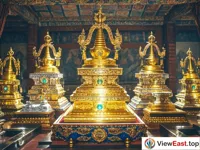







A. Scenic Spot Introduction
Potala Palace: A Sanctuary for the Soul, A Witness to History
In Lhasa, the capital city of the Tibet Autonomous Region in western China, stands a magnificent structure that captures the world's attention—the Potala Palace. This palace is not only a holy site of Tibetan Buddhism but also a microcosm of Tibetan history and culture.
Historical Culture: The Legacy of a Thousand Years of Faith
The history of the Potala Palace dates back to the 7th century when it was built by Songtsen Gampo of the Tibetan Empire to welcome his bride, Princess Wencheng. It has borne witness to the historical transformations of Tibet, carrying a wealth of religious and cultural significance. Inside the palace, there is an extensive collection of Buddha statues, murals, scriptures, and treasures, each telling a story of Tibet.
Natural Landscape: An Architectural Marvel in Harmony with Nature
The Potala Palace is built against the mountain, blending harmoniously with its natural surroundings. It sits atop Red Hill, with snow-capped mountains at its back and the Lhasa River before it, as if a guardian of the earth. Here, one can feel the perfect integration of nature and culture.
Cultural Features: A Vivid Expression of Tibetan Culture
The Potala Palace is a symbol of Tibetan culture, with its architectural style, mural art, and religious ceremonies all showcasing the wisdom and faith of the Tibetan people. Visitors can experience the unique charm of Tibetan culture and feel the people's love for life and devotion to their beliefs.
Unique Experience: A Spiritual Journey Through Time
Visiting the Potala Palace, tourists can participate in Dharma assemblies, admire Thangka paintings, and listen to monks chanting, embarking on a spiritual journey through time. Here, every brick and every tile seems to tell an ancient tale, allowing one to feel the power of faith.
Metaphor: The Potala Palace, the Pearl of the Snowy Plateau
The Potala Palace is like a radiant pearl on the snowy plateau, shining brightly from every angle. It is a sacred site in the hearts of the Tibetan people and a gem among world cultural heritage sites.
B. Travel Suggestions
Transportation Routes: From Around the World to the Potala Palace
Tourists can fly into Lhasa Gonggar Airport and then take the airport shuttle bus or a taxi to the city center. There are several public bus routes within the city that lead to the Potala Palace.
Tourism Convenience: Well-Developed Tourism Services
The area around the Potala Palace has well-developed tourism services, with a dedicated visitor center providing consultation services and guided tours to help tourists better understand the site. Additionally, there are various souvenir shops and rest areas.
Food and Accommodation: Sampling Tibetan Cuisine
There are various hotels and guesthouses in Lhasa offering accommodation services at different levels. Visitors can taste authentic Tibetan cuisine here, such as butter tea, highland barley wine, and tsampa.
Safety: A Secure Tourism Environment
Lhasa has a good public safety record, ensuring a worry-free visit for tourists. The Potala Palace, as an important cultural heritage site, also has strict security measures in place.